Factors that impair sleep quality
Computers, social networks, TV, e-books and other gadgets disrupt the body’s natural biorhythms. Ideally, we should go to bed no later than 22.00 and get up before 6.30 (with slight shifts between summer and winter). But we rarely succeed. Although no one has canceled natural rhythms.
Therefore, the body is forced to adapt to our lifestyle. Despite its high adaptability, malfunctions sometimes occur. And for some of us it becomes difficult to fall asleep and also difficult to wake up.
Why sleep disturbance is dangerous for the body
Lack of night sleep negatively affects the entire body as a whole. Well-being worsens, concentration decreases, thinking abilities deteriorate, reaction speed decreases, metabolism slows down, internal organs do not fully recover, the amount of strength decreases, and the risk of developing diseases increases.
A person who does not get enough sleep becomes more apathetic, passive, and gets tired faster. These are all the consequences of chronic lack of sleep.
It is also important to know that from 22.00 cleansing processes in the body begin. From about 10 pm to 2 am, our nervous system relaxes and restarts. In order for the process of rest for the psyche to take place efficiently, we must sleep at this time.
If you don't sleep until midnight or later, your nervous system doesn't have time to recover. A heap of feelings, problems, reactions from today flows into tomorrow. And so every day. Therefore, it is important to go to bed on time.
From 11 p.m. to 1 a.m., the gallbladder meridian is activated. If you sleep at this time, then the gallbladder works correctly and bile is released normally. The spleen and stomach are working well. If you are awake at this time, the flow of bile is disrupted, and this leads to its thickening and health problems.
From 1 to 3 o'clock the liver is cleansed. Toxins and waste are eliminated and the blood is renewed. If you want to keep your liver in order, sleep at night.

From 3 to 5 o'clock the lungs are cleared. This is a powerful organ that ensures the supply of oxygen and the removal of carbon dioxide. Normally established gas exchange protects the brain from overstrain.
From 5 to 7 am it is time to cleanse the colon. All the waste that the body has collected during the night should be eliminated from the body. Therefore, in the medicine of different nations of the world, morning bowel movements are considered an indicator of a healthy body. If the process of cleansing from toxins does not occur in the morning, then toxins begin to be absorbed into the blood. Overall this is not good for the body. It will be burdened with excess waste.
Reduced stress levels
Constant stress is a logical consequence of living in a modern city, and the dangers it poses should not be taken too lightly. Nervous stress increases blood pressure, increases the risk of heart disease, causes cancer and many other ailments. According to research published by the University of California, 70% of respondents who are exposed to stress on a daily basis admitted that they have problems sleeping. Moreover, 54% of respondents said they experienced mental health problems from anxiety over the fact that they would once again be unable to sleep through the night. Improvements with yoga before bed are attributed to the ability of meditative activity to turn off consciousness.
Focusing attention on one given point provides a path for liberation from destructive energy blocks that have formed as a result of nervous tension. A simple solution to reducing the anxiety associated with the fear of not falling asleep is to spend a few minutes each night before going to bed in a relaxation position.
Read similar: What is yoga
Yoga before bed for beginners at home - TOP 11 best asanas for good sleep
With the onset of darkness, the natural production of melatonin, a hormone that is responsible for the quality of sleep, begins.
How to calm an excited nervous system? And disconnect from thoughts? I suggest doing this by practicing yoga before bed.
#1 – Child’s pose
- Spread the mat and get down on the floor
- Bring your big toes together and spread your knees slightly apart
- Lower your body onto your hips, head to the floor at your hairline, relax your neck
- Stretch your arms forward, place them shoulder-width apart
- Stay in the pose for 60-120 seconds

#2 – Cat pose
- Get on all fours
- As you inhale, bend in the thoracic spine, bring your shoulder blades together, lift your chin up, stretch your tailbone up
- As you exhale, arch your back, point your tailbone to the floor and your chin to your sternum, stretch your back muscles
- Repeat 15-20 times
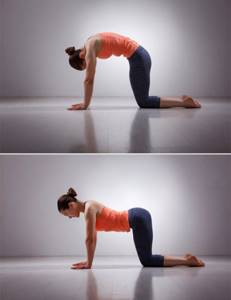
#3 – Downward Facing Dog
- Get into Child's Pose
- Get on your knees, tuck your feet, push off the floor with your hands, push your pelvis back and up, straighten your legs and arms
- Push the floor with your hands, stretch your tailbone up and your heels towards the floor
- Stay in the pose for 30-60 seconds, then rest in Child's pose. Repeat Downward Facing Dog 2-3 times
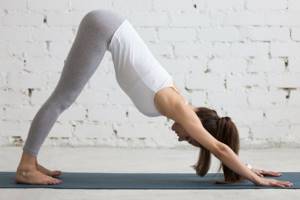
#4 – Deep Lunge
- From Downward-Facing Dog, step forward with your right foot.
- Place your foot between your palms under the center of your chest
- Stretch the heel of your left foot back
- Stay in the pose for 30 seconds. Perform with the other leg
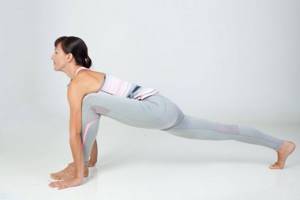
#5 – Half Pigeon Pose
- From Downward-Facing Dog, bring your right leg forward.
- Place your shin on the floor, move your knee beyond the long edge of the mat
- Check that the heel of the bent leg is at the level of the navel
- Stay in the pose for 60 seconds. Perform on the other leg
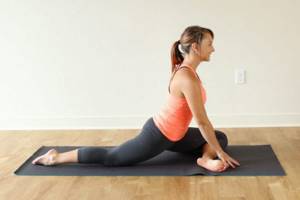
#6 – Anantasana
- Lie on the floor on your side, lower leg slightly bent
- Grab the big toe of your top foot, draw your knee in, and reach your heel toward the ceiling.
- Straighten your upper leg, gradually straighten your lower leg
- Stay in the pose for 90 seconds. Perform on the other leg

#7 – Sphinx Pose
- Lie on your stomach, straighten your legs, keep your feet hip-width apart
- Raise your body, place your elbows under your shoulders, forearms parallel to the long edges of the mat
- Press your pubic bone to the floor and stretch upward behind the crown of your head.
- Keep your chin parallel to the floor
- Stay in the pose for 90 seconds
- Once completed, perform Child's Pose
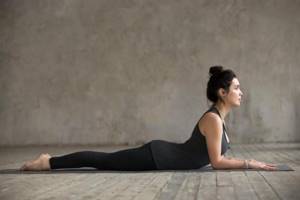
#8 – Ardha Matsyendrasana
- Sit on the floor, bend your right leg at the knee, place the heel of your right foot next to your left buttock
- Cross your left foot over your right thigh and press it to the floor.
- Turn to the left, place your right hand behind your left knee. Turn your body back
- Stay in the pose for 30 seconds. Perform in the other direction

#9 – Sarvangasana
- Lie on your back on the floor. In one motion, lift your body up and throw your legs behind your head.
- Place your elbows as close to each other as possible and place your palms on your shoulder blades
- Pushing your body towards your chin with your hands, lift your legs up
- Stay in the asana for 90 seconds
- Next, perform Halasana

#10 – Halasana
- From Sarvangasana, lower your legs behind your head onto the floor or onto a chair
- Keep your legs straight at the knees, push your pelvis up
- Stay in the asana for 90 seconds
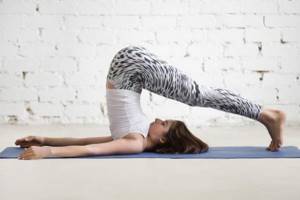
#11 – Shavasana
- Lie down on the floor (hard surface)
- Straighten your legs, place your arms along your body, palms up
- Close your eyes and relax your whole body and face
- Stay in the pose for 10 minutes
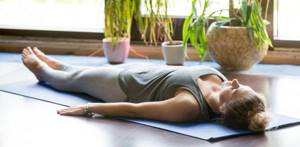
Tibetan breathing in shavasana
Why: relax the body and calm the mind, get rid of the stress of the past day and prepare for a night's rest.
At the end of the practice, perform shavasana: lie on your back so that your entire spine touches the floor, your neck and shoulders are relaxed, your arms and legs are slightly open to the sides. Close your eyes and exhale, feel how your body becomes soft and empty, all muscles, joints and ligaments relax.
Then move on to Tibetan breathing: take a full breath through your nose and exhale through a small hole between your lips and teeth with a hissing sound “Sh-sh-sh”. The face should be as relaxed as possible. Try to make your exhalations as stretched and relaxed as possible and imagine that your body is deflating like a balloon. Do 10-20 breathing cycles, then return to normal breathing and lie in shavasana for a couple more minutes.
Yoga in bed before bed - the simplest asanas
Another complex that can be done right in bed
#1 – simple twist
- Sit down, cross your legs
- Stretch your spine upward as you inhale
- With an exhalation, move your right hand behind your back, your left hand behind your right thigh.
- Repeat on the other side

#2 – Child’s pose
- Bring your big toes together
- Lean forward, lower your head onto the mattress
- Stretch your arms forward
- Stay in the pose for 5-10 minutes

#3 – butterfly
- Bring your feet together
- Pull your heels close to you
- Hold your feet with your hands
- Pull your knees down, opening your hips

#4 – knees to chest
- Lie on your back, bend your legs, pull your knees to your chest
- Grab your shins with your hands
- Apply gentle pressure to your shins with your hands, pulling your hips toward your stomach.

#5 – right angle
- Lie on a bed close to the wall
- Raise your legs straight, press them against the wall
- Stay in the pose for 5-10 minutes

Soft Paschimottanasana
Why: stretch and relax the spine, detach from the stress of the past day.
Sit on the mat, straighten and join your legs, point your toes up. Twist your pelvis slightly back, freeing your sit bones. Inhale, grab your toes with your hands, and if your back begins to tense, bend your knees. Pull your shoulders and shoulder blades back and your ribs forward and up. Then, exhaling, relax your back and lower your stomach, ribs, chest and head to your feet. Leave your hands on your feet or place them on the floor. Relax your toes and point them slightly forward, relax your shoulders and neck. Close your eyes and remain in this position for 30-60 seconds, maintaining deep, even breathing. Observe your feelings.









